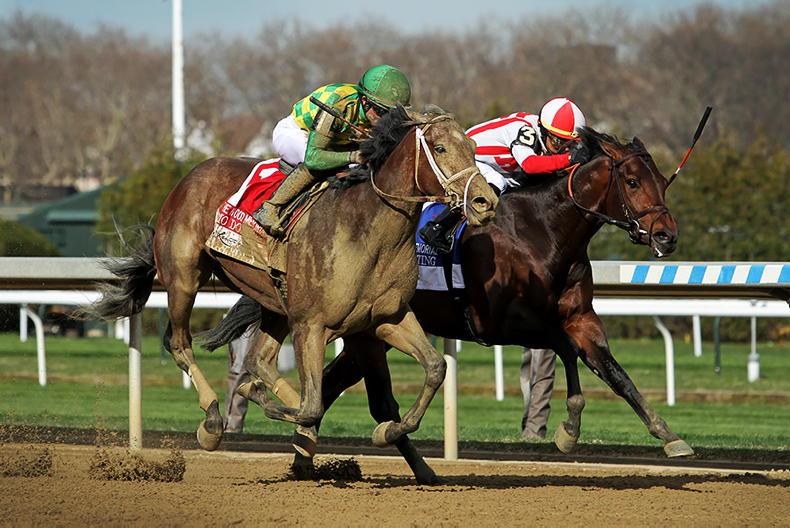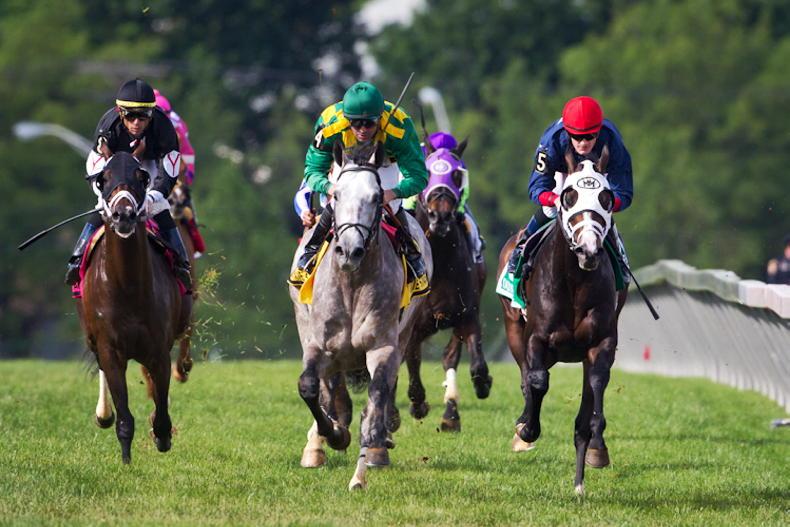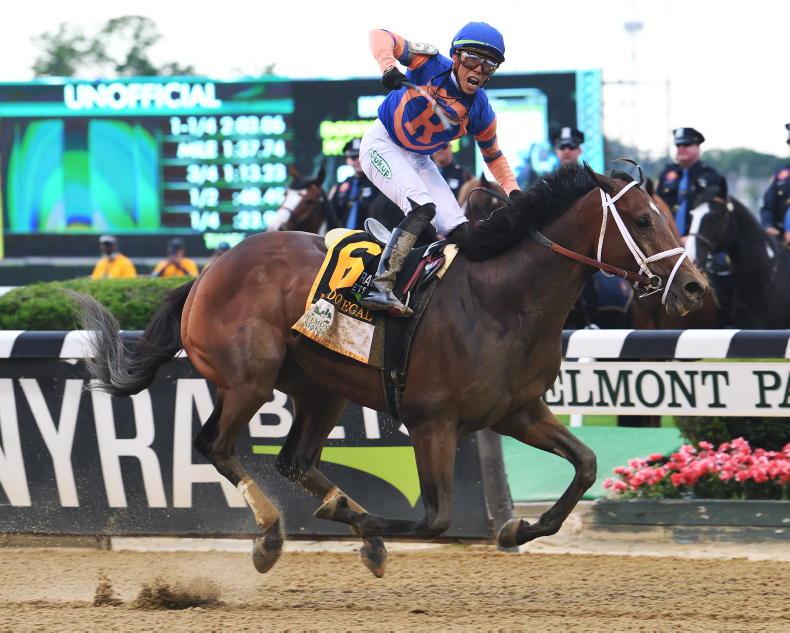“HE didn’t look like a racehorse but he looked like exactly the sort of horse that could become a racehorse.”
So said Jerry Crawford, CEO of Donegal Racing about recent Belmont Stakes winner, Mo Donegal in an interview with his local paper, the Des Moines Register before this year’s Kentucky Derby.
It was a neat synopsis of the attorney’s modus operandi when it comes to purchasing young stock, explaining why he has managed to overachieve to such a spectacular degree using a Moneyball-type formula that has yielded €13.4 million in prize money, nine Grade 1s and 117 winners out of 708 starts, for an average outlay of less than €250,000 per yearling.
Crawford seems to have the Midas touch. Apart from running his own law firm and helping Democratic presidential candidates win every Iowa Caucus since 1980, he established the successful Iowa Energy basketball team that broke League attendance records at its first game and was subsequently bought by NBA franchise Minnesota Timberwolves. He and his wife Linda even invested in what was then a little known play, A Gentleman’s Guide to Love and Murder, which went on to win four Tony awards.
That last opportunity came via one of Donegal Racing’s members and they were celebrating once more in New York when Mo Donegal glided to the front off the home turn under Irad Ortiz Jnr to prevail in the ‘Test of the Champion’ by three lengths.
As a boy from Queens, it was an emotional victory for Mike Repole, who had purchased a stake in Mo Donegal just before the Derby and in whose colours the victor ran, in deference to his local roots. He had also owned a share of the winner’s sire, Uncle Mo.
But the story was Donegal Racing, its founder, and the formula he established with his son Conor, a graduate of what is now the Godolphin Flying Start programme, to gain an edge when it came to sourcing young horses capable of winning the Kentucky Derby.
Small budgets
They haven’t managed that just yet, though in 14 years and working from comparatively small budgets compared to the heavy hitters, they have had four runners.
That in itself, is a phenomenal return. That Donegal have had had two thirds and a fifth from that representation is amazing.
The Belmont represented a new level of achievement and with Crawford showing off his yellow and green socks, it made waves in the county from which the partnership bears its name, earning coverage on the Donegal Live website and local newspapers.
Fun things
“We had several fun things happen,” Crawford reveals. “Rory McIlroy said on live television that he was pulling for Mo Donegal. Our people got pretty excited about that.
“There’s a political television broadcaster named Steve Kornacki, they had him, as if it were a political race, prognosticate and he picked Mo in the Kentucky Derby, as did a lot of others. It was just fun. I think people are just attracted to anything Irish.”
It is more than 300 years now since the Crawfords left the north west but the ‘old country’ still means a lot to Jerry.
“When my wife was pregnant – she’s Italian – we always had a deal that if the child when born looked Italian, she would name it and if the child when born looked Irish, I would name it. We ended up with Katelyn, Erin, Kathleen and Conor.”
The Irish DNA prevailed, it seems and not just in the names of the horses – Finnegan’s Wake, Arklow, Paddy O’Prado, Carrick and Dullahan being Donegal Racing’s other Grade 1 victors.
The Crawfords have been traced back to the Drumhome parish in the 1600s. It was in 1817 that James Crawford moved to Ohio. James remains the pre-eminent name in the clan, along with David.
Racing silks
“I was in Ireland with my son and we visited Donegal. The image of the Donegal county flag, which was the green and yellow blocks, that image stuck with me so when we formed Donegal Racing, those became our racing silks.”
Before all that came the absolute adoration of the horse and an intuitive understanding of it.

“My grandfather, James Crawford, loved horses. And it wasn’t horse racing, because to be honest, we didn’t have 10 cents. But we did have a love of the horse. When I was young, we had competitions to see which team of horses could pull the heaviest weight, we had the rodeo. I went twice to Omaha, the track there, Aksarben, a beautiful place that’s no longer there. We went to look at the horses in the barn in the morning and didn’t stay for the races. So for (my grandfather), it was just the animal.”
It was seeing the Tír Chonaill flag that sewed the initial seed for Donegal Racing, the title and the colours at least. But there was also ‘The Algorithm’.
Algorithm
“In 2003, my son and I started working on an algorithm to see if we could figure out mathematically, who was most likely to win the Kentucky Derby. What we discovered during about a five-year period was that we could not mathematically identify who was likely to win it.
“But we were able to identify horses that could not win. We always have 20 horses in the Kentucky Derby. If you can eliminate 15 for betting consideration, your chances are much better. One out of five instead of one out of 20. So we started doing better at the Kentucky Derby.
“I said to my wife Linda in 2008 I was going to take a little money and go to the Keeneland September Sale and buy a horse that fits the algorithm that Conor and I had been working on. She said, ‘okay, good.’
Stock market crash
“The fall of 2008, we had the stock market crash and when that happens, people stop buying luxury items, including racehorses. I got to Keeneland with €250,000 for a horse and I ended up able to buy eight horses for €420,000.
“The only problem with that was flying home to Iowa, I was figuring out how to avoid alimony when I told my wife I had bought eight horses.
“Fortunately, one of those horse was Paddy O’Prado, and he finished third in the Kentucky Derby (going on to win Donegal’s first Grade 1 in the Secretariat Stakes). That’s how it started.

“I had a group of seven or eight friends in Des Moines, Iowa and they had always been saying, ‘Jerry, go buy a horse and we’ll all go in partnership on it’’ So I’m thinking, ‘gosh, I hope they weren’t kidding’. It turns out they were raring to go and we’ve been at it ever since.”
From an initial seven partners, there were 54 last year, ranging from students to retired people looking to mix it in the Big League on Little League budgets. That expansion is by dint of results, as they don’t advertise.
Disappointed
“We are different in that we only do one partnership a year. If you buy, let’s say, two per cent, you own two per cent of every horse we buy that year, which is usually eight or 10 horses. That way, if we have a big horse in any year, nobody gets left out or feels like they bought the wrong horse. Nobody ever feels disappointed.”
That counts for friends and family too. They were around 350 in the Donegal Racing party at Churchill Downs for the Derby, with around 280 making the trip to Belmont Park.
This year, Crawford has decided to give winning jockeys future stallion shares as an added initiative.
But it all goes back to the algorithm. Readers may have seen Brad Pitt in the film Moneyball, based on Michael Lewi’s brilliant book of the same name about baseball general manager Billy Beane’s methodology in sourcing players for his franchise, the Oakland A’s, without a George Steinbrenner to pay for them.
These players tended to be undervalued due to old tropes and aesthetics but Beane focussed on the numbers and Oakland overachieved repeatedly. Crawford says it’s a fair comparison.
“Our algorithm measures what we think the horse is capable of from a stamina standpoint and from a class standpoint. And those of course are the two man requisites to win race like the Kentucky Derby or the Belmont Stakes.
“We’ve actually been in the Kentucky Derby four times in 14 years, which I think is pretty remarkable considering we spend less than any other partnership in our entire country.
“We’ve won nine or 10 Grade 1s races and the average purchase price of those horses was €140,000. As you well know, people are spending three-quarters of a million and up for those kind of horses.
“We get notes and letters and emails from time to time, from people from Ireland and from Donegal, and I can’t tell you how touching that is.
Ordinary people
“So, we have figured out a way that we’re proud of and that we think can allow ordinary people to be successful in horse racing without being millionaires and billionaires.”
He laughs when asked how many blank cheques he has been offered for the formula. People know it’s not for sale now, he asserts with a chuckle, though there are some tentative queries still from time to time.
“We do a lot more than just the algorithm but we start with the algorithm,” he expands. “We put every single horse at the five sales we go to through the algorithm. We do a lot of different tests but in an average group of a 100 horses, the algorithm will throw 90 to the wayside.
“While we don’t spend a tremendous amount on the horses, we do spend a tremendous amount on the testing considering our budget and that’s how we find horses that have the potential to outperform or outkick what might appear on the surface.
“After the algorithm, we measure cardios and biomechanicals, have six different spotters that give their conformation opinion, have a vet that scopes the throat, have a vet that examines radiographs of all areas of concern, especially joints. This is over and above the algorithm, which is where each inspection starts.”
One imagines he is watched like a hawk at the sales, for what he is viewing and what he bids on.
“Whenever we’ve a big horse like Mo Donegal this year, my wife Linda notices that there are people following us around the sale grounds. She’s not somebody to be messed with, so if she sees somebody trying to get too close, she’s quick to encourage them to move on!”
There is a real sense of what might have been about the Kentucky Derby. Crawford had been convinced Mo Donegal would win. But having been drawn on the rail, he broke badly and was stuck in the back.
While winner Rich Strike was able to navigate a path up the inner from a similar initial position, Mo Donegal lost ground out wide and ended a staying-on fifth.
Redemption was just around the corner however.

Mo Donegal and Irad Ortiz win the Grade 1 Belmont Stakes in co-owner Mike Repole's colours \ Coglianese Photos
“I’m reminded of what a reporter said to me at Belmont. He said, ‘how did you feel when the horses turned for home?’ I thought to myself, ‘I’m going to be able to die a happy man.’ That said, we would still like to win the other two legs of the Triple Crown.”
The deal with Repole was another example of Crawford delivering for his partners. A 25% share of Mo Donegal was sold, representing a lucrative return, and among the add-ons was that the billionaire entrepreneur would pay another million if the horse won a Grade 1 after the Derby.
With more money in the pot, does it mean Crawford will be increasing his spend?
“I think we will go up a little in what we pay but it’s not because of our success, it’s because there’s been an inching up of prices. I don’t think I need to average €250,000, I think I can be just short of that and be successful but that would be a step up in itself. Mo Donegal cost us €250,000.
“He was the most expensive horse we bought as a yearling, so I think that’s kind of instructive. You don’t have to go beyond that, but you probably do need to be able to reach that number.”
Deliberations on the future for Mo Donegal are ongoing. The Travers is a possibility, a race in which Donegal Racing’s Keen Ice beat American Pharoah in 2015, having finished third in the Derby.

Donegal Racing CEO Jerry Crawford and jockey Irad Ortiz, Jr \ Scott G. Serio/Eclipse Sportswire/CSM
Irish home
And as for racing at four or having a stallion career?
“We’d like him to have a nice Irish home. Maybe with Coolmore?” comes the instant response with a flashing smile.
“You have to see how’s the horse doing. What’s he telling you? You’re constantly evaluating all the variables.”
Crawford has raced in Ireland often and attended the Irish Derby. He did send a horse to be trained here once but injury prevented it ever making the track.
“It’s a lot, first buying the right horses to send to Ireland and second, to help manage the horses’ training and racing careers over there. But my partners ask about it all the time.
“The purses need to be sufficient to make it economically sane. This is true everywhere, this is not Irish-specific. But I think throughout Europe, people are feeling that the purses need to be higher. Is that a fair statement?”
The volume of racehorse traffic to America from these shores provides that answer but Crawford does say if it can make economic sense to race horses here, “it would be fun.”
Anti-doping
Back in the States, HISA (Horseracing Integrity and Safety Authority) was launched on July 1st. There have already been lots of changes from its initial construct, not least with the authority failing to come to an agreement with USADA to oversee their anti-doping enforcement programme, which has had its implementation postponed now until January 1st. Other rules, such as those surrounding whip specifications have also been put back.
“Any time you attempt a change of this magnitude, there’s going to be a lot of frustration.
“In my age bracket, I’m not as computer literate as my children are or their children are, so I think a lot of people in my age bracket are finding it difficult to keep up with all you need to do to comply with all the requirements, signing up, maintaining.
“There was a big issue over who signs the horse up. Is it the trainer? Is it the owner? Is it either one? If you’re in a partnership, does just one person need to sign the horse up?
“There’s a lot of complication and I think they need to iron that out before they throw the ‘go’ switch. But I also think there’s a lot of energy behind it.
“When I see 300 people show up for one horse at the races, it’s pretty hard to say that the interest is down.
“I think American racing is in better shape than some people give it the credit for. Which doesn’t mean there aren’t things we can do better. There are.
Medication
“People keep talking about different medication rules from one state to the next in the United States. It’s not just that.
“The back and forth overseas about medication. It would be nice if we were all on the same page that way also.”
A global standard should be an achievable common goal, going back to the core love of the horse, the likes of which his grandfather passed on to him.
“I couldn’t agree more.”
Meanwhile, it’s onwards and upwards for Donegal Racing, and its growing fanbase across the Atlantic.
“We get notes and letters and emails from time to time, from people from Ireland and from Donegal, and I can’t tell you how touching that is.
“I hope that if anybody in Ireland, anybody from Donegal wants to see some of our horses race, you’d be welcome anytime.”
For further information on Donegal Racing, go to www.donegalracing.com.


 This is a subscriber-only article
This is a subscriber-only article
 It looks like you're browsing in private mode
It looks like you're browsing in private mode









SHARING OPTIONS: